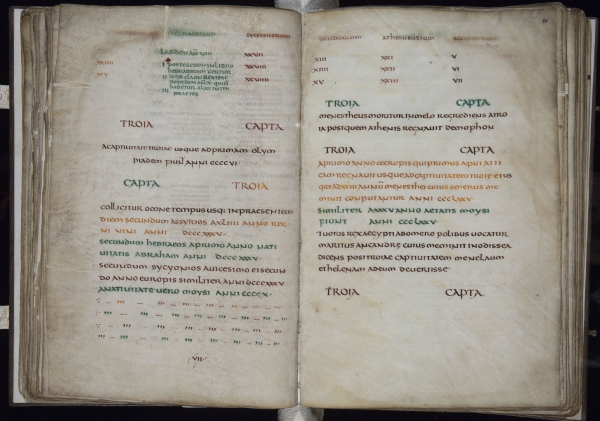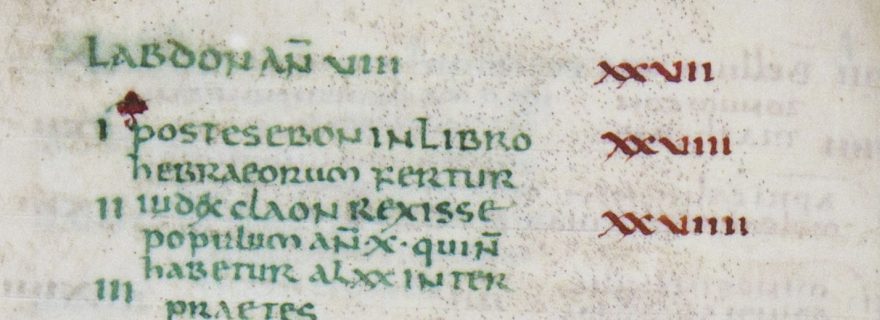World History in a Carolingian Manuscript
Remarkably fine copy of the Chronicle of Eusebius-Jerome.
Scaliger MS 14 is a remarkably fine copy of the Chronicle of Eusebius-Jerome, made in the early ninth century in northern France. The Chronicle – first written in Greek in the fourth century by Eusebius of Caesarea — is a so-called ‘universal history’. It covers the story of the world from its Creation, with the histories of many empires and kingdoms – of the Assyrians, Medes, Persians, Egyptians, Athenians, Macedonians, Greeks, Hebrews, Romans and Christians – intertwined, up to 326. Jerome, who also translated much of the Bible into what we know as the Vulgate, translated the Chronicle into Latin and added a section for the years 327-378, probably completing it in AD 380.
The Chronicle is not, however, a continuous narrative about the succession of empires, for it is presented in columns. In most early copies, the first column of the left hand side of the page records the Annus mundi, years since the Creation. Olympiads are also cited for chronological orientation as well as the regnal years of kings, judges, archons and emperors. The Chronicle is then constructed in relation to these columns of dates in columns spread usually over two pages, that is, an opening. From the perspective of two authors living in the Christian Roman empire, this annotated chronology of world history can be understood not just as world history, but also as a moral display of human vainglory. It is also in a sense a cultural and historical map, for visually and succinctly it sets out and locates in time the relationship between the various elements of an educated Christian’s universe.
Surviving manuscripts of Eusebius-Jerome reflect the weight different scribes, presumably responding to or endeavouring to direct the interests of particular readers, ascribed to particular events. Scaliger 14, for instance, has a particularly dramatic presentation of the Fall of Troy, with repetitions of TROIA CAPTA in large red capitals and accompanying text occupying the bottom half of the opening. In contrast the birth of Christ is simply one of a number of events in that section of the manuscript. The character of its minuscule script indicates that it was written by one of the groups of scribes closely associated with the Frankish royal court, and it is possible that the recipient of this codex was Charlemagne himself.
Although the scribes of Scaliger 14 modelled the layout of the text on fifth-century exemplars, such as that of the fifth-century Italian fragment now Leiden Vossius Q. Lat. 110 A (regarded as the best representative of the original form of the text), in the number of lines and precise elements of the layout, as distinct from the text, Scaliger 14 does not conform with any other known early manuscript of the Chronicle. This means that the scribe appears to have devised his own layout in reacting to the content of the text, rather than slavishly following any model. The column layout was emulated by many other universal chroniclers in the later middle ages, not least Werner Rolevink’s Fasciculus temporum
This post was made by Rosamond McKitterick, University of Cambridge, Scaliger Fellow in Leiden University Library in 2010.




